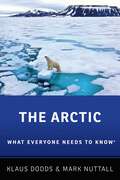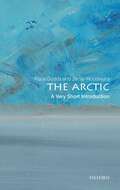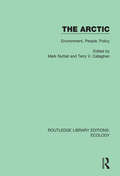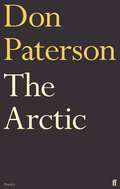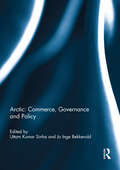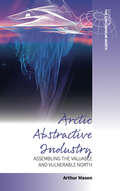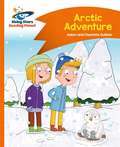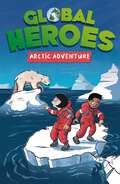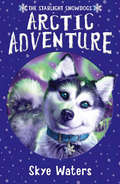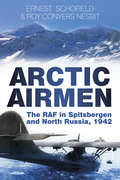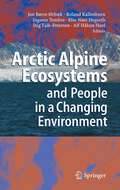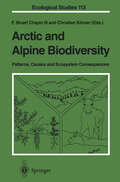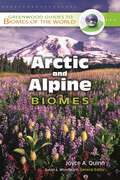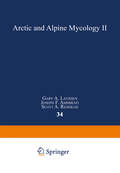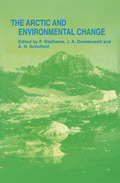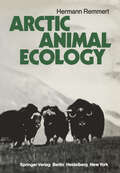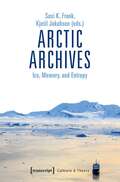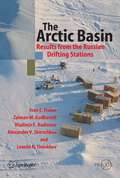- Table View
- List View
The Arctic: What Everyone Needs to Know® (What Everyone Needs To Know®)
by Klaus Dodds Mark NuttallConversations defining the Arctic region often provoke debate and controversy -- for scientists, this lies in the imprecise and imaginary line known as the Arctic Circle; for countries like Canada, Russia, the United States, and Denmark, such discussions are based in competition for land and resources; for indigenous communities, those discussions are also rooted in issues of rights. These shifting lines are only made murkier by the threat of global climate change. In the Arctic Ocean, the consequences of Earth's warming trend are most immediately observable in the multi-year and perennial ice that has begun to melt, which threatens ice-dependent microorganisms and, eventually, will disrupt all of Arctic life and raise sea levels globally. In The Arctic: What Everyone Needs to Know®, Klaus Dodds and Mark Nuttall offer concise answers to the myriad questions that arise when looking at the circumpolar North. They focus on its peoples, politics, environment, resource development, and conservation to provide critical information about how changes there can, and will, affect our entire globe and all of its inhabitants. Dodds and Nuttall explore how the Arctic's importance has grown over time, the region's role during the Cold War, indigenous communities and their history, and the past and future of the Arctic's governance, among other crucial topics.
The Arctic: What Everyone Needs To Know® (Very Short Introductions)
by Klaus Dodds Jamie WoodwardVery Short Introductions: Brilliant, Sharp, Inspiring The Arctic is demanding global attention. It is warming, melting, and thawing in a manner that threatens fundamental state-change. For communities that call the Arctic 'home' this is unwelcome. A warming Arctic brings with it the spectre of costly disruption and interference in indigenous lives and communal welfare. For others, the disappearance of sea ice makes the Arctic appear more accessible and less remote. This also brings with it dangers such as the prospect of a new era of great power rivalries involving China, Russia, and the United States. Submarine and long-range bomber patrolling are now commonplace. New terms such as 'global Arctic' are being used to capture the dynamic of change while others muse about the 'return of a Cold War'. The reality is inevitably more complex. The physical geography of the Arctic is highly varied and variable. Environmental change brings opportunities for indigenous and non-indigenous life-forms to survive and even thrive. The Arctic's four million people are not helpless pawns in a game of global geopolitics. The Arctic is not only a resource hotspot but also a place where sustainable energy systems are being introduced. A warming Arctic with less ice and permafrost is not unique in the longer history of the Earth either. The Arctic is a complex space. In this Very Short Introduction, Klaus Dodds and Jamie Woodward consider the major dimensions of the region and the linkages beyond - from the geopolitical to the environmental. They examine the causes, drivers, and effects of cultural, physical, political, and economic change, and ponder the future of the Arctic. As they show, it is a future which will affect us all. ABOUT THE SERIES: The Very Short Introductions series from Oxford University Press contains hundreds of titles in almost every subject area. These pocket-sized books are the perfect way to get ahead in a new subject quickly. Our expert authors combine facts, analysis, perspective, new ideas, and enthusiasm to make interesting and challenging topics highly readable.
The Arctic: Environment, People, Policy (Routledge Library Editions: Ecology #10)
by Mark Nuttall; Terry V. CallaghanOriginally published in 2000, The Arctic provides a comprehensive overview of the region's rapidly changing physical and human dimensions, and demonstrates the importance of communication between natural scientists, social scientists, and local stakeholders in response to the tremendous challenges and opportunities facing the Arctic. It is an essential resource for all Arctic researchers, particularly those developing multidisciplinary projects. It provides an overview of key areas of Arctic research by renowned specialists in the field, and each chapter forms a detailed, varied and accessible account of current knowledge. Each author introduces the subject to a specialist readership, while retaining intellectual integrity and relevance for specialists. Overall, the richness of the material presented in this volume reflects the ecological and cultural diversity of this vast and environmentally critical part of the globe.
The Arctic: Environment, People, Policy (Routledge Library Editions: Ecology #10)
by Mark Nuttall Terry V. CallaghanOriginally published in 2000, The Arctic provides a comprehensive overview of the region's rapidly changing physical and human dimensions, and demonstrates the importance of communication between natural scientists, social scientists, and local stakeholders in response to the tremendous challenges and opportunities facing the Arctic. It is an essential resource for all Arctic researchers, particularly those developing multidisciplinary projects. It provides an overview of key areas of Arctic research by renowned specialists in the field, and each chapter forms a detailed, varied and accessible account of current knowledge. Each author introduces the subject to a specialist readership, while retaining intellectual integrity and relevance for specialists. Overall, the richness of the material presented in this volume reflects the ecological and cultural diversity of this vast and environmentally critical part of the globe.
The Arctic
by Don PatersonIn this new collection from Don Paterson, 'The Arctic' is the bar frequented in the backstreet of a post-apocalyptic world. Under its echoey aegis are gathered poems about men and women, polemical responses to a pandemic, microdot poems, odes to dogs, to movies and the male anatomy, and, in the chill undertow, a series of poems that mourn the poet's musician father. Other poets are drawn in from the cold, including the Chilean poet, Gabriela Mistral, whose verses are magically transformed to Paterson's native Scots; there are versions, too, of Cavafy, Montale and Unamuno. And in the fourth part Paterson's ongoing long poem 'The Alexandrian Library', travelling from a weather station at the top of Ben Nevis to the cellar back at The Arctic Bar, we are witness to the imminence of man-made extinction. By turn, urgent, railing, tender, these are poems for our times, by one of our most celebrated and formally adventurous poets.
Arctic: Commerce, Governance And Policy
by Uttam Kumar Sinha Jo Inge BekkevoldIn May 2013, China, India, Japan, Singapore and South Korea (Asia 5) were given status as permanent observers in the Arctic Council. It was a symbolic and significant moment in the history of Arctic affairs. The list of stakeholders in the Arctic has now expanded to include both the Arctic littoral states and the five Asian states. The drivers and policies of these stakeholders on the Arctic vary, but research on climate change, possible changes to the global energy and minerals markets, adherence to international norms like the UNCLOS, and geopolitical considerations are issues of concern. This volume is based on the reviewed, revised and updated versions of papers presented at the roundtable on The Geopolitics of the Arctic: Commerce, Governance and Policy hosted by the Institute for Defense Studies and Analyses (IDSA) in New Delhi in September, 2013, in joint co-operation with the Fridtjof Nansen Institute (FNI), the Norwegian Institute for Defence Studies (IFS) and Peace Research Institute Oslo (PRIO).We hope that this book, with some compelling perspectives on a number of challenging issues, will help engage the policy community to identify and explore opportunities for international cooperation in the Arctic. This book was originally published as a special issue of Strategic Analysis.
Arctic: Commerce, Governance And Policy
by Uttam Kumar Sinha and Jo Inge BekkevoldIn May 2013, China, India, Japan, Singapore and South Korea (Asia 5) were given status as permanent observers in the Arctic Council. It was a symbolic and significant moment in the history of Arctic affairs. The list of stakeholders in the Arctic has now expanded to include both the Arctic littoral states and the five Asian states. The drivers and policies of these stakeholders on the Arctic vary, but research on climate change, possible changes to the global energy and minerals markets, adherence to international norms like the UNCLOS, and geopolitical considerations are issues of concern. This volume is based on the reviewed, revised and updated versions of papers presented at the roundtable on The Geopolitics of the Arctic: Commerce, Governance and Policy hosted by the Institute for Defense Studies and Analyses (IDSA) in New Delhi in September, 2013, in joint co-operation with the Fridtjof Nansen Institute (FNI), the Norwegian Institute for Defence Studies (IFS) and Peace Research Institute Oslo (PRIO).We hope that this book, with some compelling perspectives on a number of challenging issues, will help engage the policy community to identify and explore opportunities for international cooperation in the Arctic. This book was originally published as a special issue of Strategic Analysis.
The Arctic: A Very Short Introduction (Very Short Introductions)
by Klaus Dodds Jamie WoodwardVery Short Introductions: Brilliant, Sharp, Inspiring The Arctic is demanding global attention. It is warming, melting, and thawing in a manner that threatens fundamental state-change. For communities that call the Arctic 'home' this is unwelcome. A warming Arctic brings with it the spectre of costly disruption and interference in indigenous lives and communal welfare. For others, the disappearance of sea ice makes the Arctic appear more accessible and less remote. This also brings with it dangers such as the prospect of a new era of great power rivalries involving China, Russia, and the United States. Submarine and long-range bomber patrolling are now commonplace. New terms such as 'global Arctic' are being used to capture the dynamic of change while others muse about the 'return of a Cold War'. The reality is inevitably more complex. The physical geography of the Arctic is highly varied and variable. Environmental change brings opportunities for indigenous and non-indigenous life-forms to survive and even thrive. The Arctic's four million people are not helpless pawns in a game of global geopolitics. The Arctic is not only a resource hotspot but also a place where sustainable energy systems are being introduced. A warming Arctic with less ice and permafrost is not unique in the longer history of the Earth either. The Arctic is a complex space. In this Very Short Introduction, Klaus Dodds and Jamie Woodward consider the major dimensions of the region and the linkages beyond - from the geopolitical to the environmental. They examine the causes, drivers, and effects of cultural, physical, political, and economic change, and ponder the future of the Arctic. As they show, it is a future which will affect us all. ABOUT THE SERIES: The Very Short Introductions series from Oxford University Press contains hundreds of titles in almost every subject area. These pocket-sized books are the perfect way to get ahead in a new subject quickly. Our expert authors combine facts, analysis, perspective, new ideas, and enthusiasm to make interesting and challenging topics highly readable.
Arctic Abstractive Industry: Assembling the Valuable and Vulnerable North (Studies in the Circumpolar North #5)
by Arthur MasonThrough diverse engagements with natural resource extraction and ecological vulnerability in the contemporary Arctic, contributors to this volume apprehend Arctic resource regimes through the concept of abstraction. Abstraction refers to the creation of new material substances and cultural values by detaching parts from existing substances and values. The abstractive process differs from the activity of extractive industries by its focus on the conceptual resources that conceal processes of exploitation associated with extraction. The study of abstraction can thus help us attune to the formal operations that make appropriations of value possible while disclosing the politics of extraction and of its representation.
Arctic Abstractive Industry: Assembling the Valuable and Vulnerable North (Studies in the Circumpolar North #5)
by Arthur MasonThrough diverse engagements with natural resource extraction and ecological vulnerability in the contemporary Arctic, contributors to this volume apprehend Arctic resource regimes through the concept of abstraction. Abstraction refers to the creation of new material substances and cultural values by detaching parts from existing substances and values. The abstractive process differs from the activity of extractive industries by its focus on the conceptual resources that conceal processes of exploitation associated with extraction. The study of abstraction can thus help us attune to the formal operations that make appropriations of value possible while disclosing the politics of extraction and of its representation.
Arctic Abstractive Industry: Assembling the Valuable and Vulnerable North (Studies in the Circumpolar North #5)
by Arthur MasonThrough diverse engagements with natural resource extraction and ecological vulnerability in the contemporary Arctic, contributors to this volume apprehend Arctic resource regimes through the concept of abstraction. Abstraction refers to the creation of new material substances and cultural values by detaching parts from existing substances and values. The abstractive process differs from the activity of extractive industries by its focus on the conceptual resources that conceal processes of exploitation associated with extraction. The study of abstraction can thus help us attune to the formal operations that make appropriations of value possible while disclosing the politics of extraction and of its representation.
Arctic Adventure (Rising Stars Reading Planet Ser.)
by Helen ChapmanSome little owl chicks have just hatched at the wildlife park! When Tess and Finn go to see them, they're swept away to meet some snowy owl chicks – in the Arctic! The owls are hungry and cold, because their mother is missing! Can Finn and Tess find the mother snowy owl? Arctic Adventure is part of the Comet Street Kids range of books from Rising Stars Reading Planet. Comet Street Kids is an action-packed character series with highly decodable books for Pink A to White band. Children will love experiencing the amazing adventures of Rav, Asha, Tess, Finn and Stefan! Reading Planet books have been carefully levelled to support children in becoming fluent and confident readers. Each book features useful notes and activities to support reading at home as well as comprehension questions to check understanding. Reading age: 5-6 years
Arctic Adventure (Global Heroes #4)
by Damian HarveyJoin our team of Global Heroes in this fast-paced, science-themed chapter book set in the abominably cold arctic!Great for readers age 7+ these adventure stories are also full of fascinating facts. These illustrated chapter books are perfect for making fascinating science topics accessible to young readers, inspiring a thirst for knowledge and learning by stealth. The team of characters come from around the world to give a truly global outlook.
Arctic Adventure (Starlight Snowdogs #2)
by Skye WatersJoin Ella and her husky puppy on magical adventures with the Starlight Snow Dogs!
Arctic Airmen: The RAF in Spitsbergen and North Russia, 1942
by Ernest Schofield Roy Conyers NesbitIn 1942 a Catalina crew of 210 Squadron, based at Sullom Voe in the Shetlands, was selected to carry out a series of highly secret operations, including a flight to the North Pole. The sorties were associated with a Norwegian expedition from Britain to Spitsbergen, to deny the use of the territory to the enemy. The flights made by the crew were frequently over twenty-four hours in length and reached the limits of human endurance, in conditions of extreme cold. Later, the squadron was detached to North Russia, to provide cover for the convoys taking vital supplies to the Allies on the Eastern Front. The navigator of the crew, Ernest Schofield, retained logs of most of these sorties. Together with other survivors of the crew, accounts from German sources and research carried out by Roy Conyers Nesbit, he recreated these little-known events, in detailed and accurate narrative that ends in tragedy.
Arctic Alpine Ecosystems and People in a Changing Environment
by Ingunn Tombre Else N. Hegseth Stig Falk-Petersen Alf H. Hoel Jon Børre Ørbaek Roland KallenbornThe European Arctic and Alpine regions are experiencing large environmental changes. These changes may have socio-economic effects if the changes affect the bioproduction, which form the basis for the marine and terrestrial food chains. This uniquely multidisciplinary book presents the various aspects of contemporary environmental changes in Arctic and Alpine Regions.
Arctic and Alpine Biodiversity: Patterns, Causes and Ecosystem Consequences (Ecological Studies #113)
by F. Stuart Iii Chapin Christian KörnerAs human populations expand and have increasing access to technol ogy, two general environmental concerns have arisen. First, human pop ulations are having increasing impact on the earth system, such that we are altering the biospheric carbon pools, basic processes of elemental cycling and the climate system of the earth. Because of time lags and feedbacks, these processes are not easily reversed. These alterations are occurring now more rapidly than at any time in the last several million years. Secondly, human activities are causing changes in the earth's biota that lead to species extinctions at a rate and magnitude rivaling those of past geologic extinction events. Although environmental change is potentially reversible at some time scales, the loss of species is irrevo cable. Changes in diversity at other scales are also cause for concern. Habitat fragmentation and declines in population sizes alter genetic di versity. Loss or introduction of new functional groups, such as nitro gen fixers or rodents onto islands can strongly alter ecosystem processes. Changes in landscape diversity through habitat modification and frag mentation alter the nature of processes within and among vegetation patches. Although both ecological changes altering the earth system and the loss of biotic diversity have been major sources of concern in recent years, these concerns have been largely independent, with little concern for the environmental causes the ecosystem consequences of changes in biodiversity. These two processes are clearly interrelated. Changes in ecological systems cause changes in diversity.
Arctic and Alpine Biomes (Greenwood Guides to Biomes of the World)
by Joyce A. QuinnThis volume in the Greenwood Guides to Biomes of the World: series covers the biomes at high altitudes and near the poles, including the arctic tundra biomes, the Mid-Latitude Alpine Tundra Biome (found in the mountain ranges of North America, Asia, and South America), and the tropical alpine tundra biome (for example, Hawaii).
Arctic and Alpine Mycology II (Environmental Science Research #34)
by Gary A. Laursen Joseph F. Ammirati Scott A. RedheadDuring the summer of 1980, the First International symposium on Arctic and Alpine Mycology (ISAM-I) was held at the then extant Naval Arctic Research Laboratory near Barrow, Alaska, U.S.A., well within the Arctic Circle (Laursen and Ammirati, Arctic and Alpine Mycology. The First International symposium on Arcto-Alpine Mycology. Univ. Wash. Press, 1982). The facility is currently owned and operated by the Utkeagvik Inupiat community and is named the National Academic and Research Laboratory, thus retaining its acronym NARL. Twenty-five scientists participated in that historic first meeting. Their interests in the fungi spanned a vast geographic area of cold dominated habitats in both the northern and southern hemispheres that included four continents (N. and S. America, Eurasia,and Antarctica), nine countries, and numerous islands ranging from Greenland to Jan Mayen in the Svalbard group. ISAM-I helped to develop ongoing interests and initiate others. This is what ISAM-I founders hoped would happen. Asa result, the organizing committee for ISAM-II was formed. Its mandate was to: involve a maximum of one third new participants in future ISAM meetings: divide the responsibility for organizing future meetings at sites located in areas of interest to research thrusts in Arctic and alpine environments: keep the number of participants small enough to ensure manageability, taking full advantage of field collecting opportunities with minimal complications and cost.
Arctic and Environmental Change
by J. A. DowdeswellThis timely book presents a wide-ranging review of Arctic environmental change in response to global warming, and gives a broad insight into the transformation of the Arctic which we can expect during the next century. It is in high northern latitudes that we can expect to observe global warming at its most powerful, making it a natural laboratory where climate changes and their impacts can be monitored and studied more readily than elsewhere in the world. Fourteen authoritative reviews cover the predictions of warming rates by General Circulation Models; variabilities in atmospheric circulation and moisture flux; the dynamics of the polar vortex in the Arctic and its role in ozone loss; the countervailing influence of air pollution in reducing solar irradiance; and the impact of climatic change on Arctic terrestrial and marine ecosystems. Also detailed are the thermohaline circulation of the ocean, the extent and thickness of sea ice, the sizes of glaciers and ice sheets, and the extent of permafrost. Moving to past changes, the records from Greenland ice cores and deep ocean drilling are reviewed for what they tell us about past climates and glaciation in the Arctic., The book paints a vivid and disturbing picture of the enhanced warming that can be expected in the Arctic relative to lower latitudes, and of the major impacts that this will have on the northern cryosphere. It will be an invaluable reference for anyone seeking a greater understanding of the factors and processes affecting the arctic environment, which may ultimately have a major impact on global climatic change.
Arctic and Environmental Change
by J. A. DowdeswellThis timely book presents a wide-ranging review of Arctic environmental change in response to global warming, and gives a broad insight into the transformation of the Arctic which we can expect during the next century. It is in high northern latitudes that we can expect to observe global warming at its most powerful, making it a natural laboratory where climate changes and their impacts can be monitored and studied more readily than elsewhere in the world. Fourteen authoritative reviews cover the predictions of warming rates by General Circulation Models; variabilities in atmospheric circulation and moisture flux; the dynamics of the polar vortex in the Arctic and its role in ozone loss; the countervailing influence of air pollution in reducing solar irradiance; and the impact of climatic change on Arctic terrestrial and marine ecosystems. Also detailed are the thermohaline circulation of the ocean, the extent and thickness of sea ice, the sizes of glaciers and ice sheets, and the extent of permafrost. Moving to past changes, the records from Greenland ice cores and deep ocean drilling are reviewed for what they tell us about past climates and glaciation in the Arctic., The book paints a vivid and disturbing picture of the enhanced warming that can be expected in the Arctic relative to lower latitudes, and of the major impacts that this will have on the northern cryosphere. It will be an invaluable reference for anyone seeking a greater understanding of the factors and processes affecting the arctic environment, which may ultimately have a major impact on global climatic change.
Arctic Animal Ecology
by Hermann RemmertA large number of comprehensive publications has been devoted to the Antarctic, to its plant and animal life. It is therefore relatively easy to familiarize oneself with the current state of Antarctic research. Nothing comparable is available for the Arctic. The heterogeneity and richness of the northern polar regions seem to have discouraged any attempt at a synthethic approach. This book has evolved from an attempt to summarize the results of 15 years of ecological and physiological research work in the Arctic - mostly on Spitsbergen. The necessity of comparing our results and the ecological conditions of Spitsbergen with other arctic regions grew into a full-sized book on arctic animal ecology. It is not meant as an exhaustive survey ofthe relevant literature. Instead I have tried to show how closely the various fields of research are interwoven, how many questions can be solved if only notice is taken of fellow scientists and their results, and how much arctic animals have in common. This book would not have been possible without the helpfulness of many colleagues. Above all I should like to mention Professor Ronning and Professor Solem of Trondheim University (Norway), Professor Arnthor Gardasson of Reykjavik University (Iceland), Dr. NettIeship, Dr. Oliver and Dr. Ryder of Canada and Professor West of Fairbanks University (Alaska, USA).
Arctic Archives: Ice, Memory and Entropy (Edition Kulturwissenschaft #194)
by Susi K. Frank Kjetil A. JakobsenThis pioneering volume explores the Arctic as an important and highly endangered archive of knowledge about natural as well as human history of the anthropocene. Focusing on the Arctic as an archive means to investigate it not only as a place of human history and memory - of Arctic exploring, ›conquering‹ and colonizing -, but to take into account also the specific environmental conditions of the circumpolar region: ice and permafrost. These have allowed a huge natural archive to emerge, offering rich sources for natural scientists and historians alike. Examining the debate on the notion of (›natural‹) archive, the cultural semantics and historicity of the meaning of concepts like ›warm‹, ›cold‹, ›freezing‹ and ›melting‹ as well as various works of literature, art and science on Arctic topics, this volume brings together literary scholars, historians of knowledge and philosophy, art historians, media theorists and archivologists.
The Arctic Basin: Results from the Russian Drifting Stations (Springer Praxis Books)
by Ivan E. Frolov Zalman M. Gudkovich Vladimir F. Radionov Alexander V. Shirochkov Leonid A. TimokhovArctic Bf 109 and Bf 110 Aces (Aircraft of the Aces #124)
by John WealOnce Nazi Germany had conquered Norway in 1940, just a handful of Gruppen flying the Bf 109 and Bf 110 fighters were able to shatter all opposition and dominate the air in the Arctic Circle. Yet as the dual threats of the RAF and the Red Air Force grew, the Luftwaffe was forced to increase its fighter presence to full Geschwader strength with the formation of JG 5 Eismeer (Ice-sea) in early 1942.The struggle for the frozen skies of the arctic raged on until the end of the war as the embattled JG 5 produced some of the Eastern Front's leading aces, pilots of the calibre of Theodor Weissenberger, Heinrich Ehrler, Walter Schuck, Franz Dörr and Jakob Norz all achieving over 100 kills. Featuring first-hand accounts from the pilots, extensive research from a leading authority on the Luftwaffe, and illustrations of the aircraft in unique winter camouflage, this book is a comprehensive guide to the Arctic Experten and the planes they flew.
